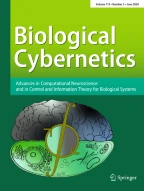Abstract
High-frequency electrical stimulation in the hippocampus leads to an increase in synaptic efficacy that lasts for many hours. This long-term potentiation (LTP) of synaptic transmission is presumed to play a crucial role in learning and memory in the brain. However, the frequency of stimulation generally used to obtain LTP is beyond the normal physiological range of activity of hippocampal neurons. We found that LTP can be induced by an electrical stimulation whose frequency is comparable to that of the naturally occurring firing activity of hippocampal neurons if the stimulating pulseinterval train has a special time structure. In the present experiment, we compared the magnitude of LTP induced by the four types of stimuli which have the same pulse number and the same mean frequency but different time structure in interstimulus intervals. One type of stimuli has regular intervals, and this served as a control stimulus. In the other three types of stimuli, the adjacent interstimulus interval had the following statistical properties: in type 1, their correlations are positive; in type 2, negative; and in type 3, independent. The magnitude of LTP induced by these four types of stimuli showed clear order relationships: type 3/type 1≫ control > type 2. Detailed analysis of the evoked potential during a period of temporal pattern stimulation revealed that the amplitude of the population spikes of repetitive firing, especially of the second and third population spikes, had the same order relationship as the LTP. Because 2-amino-5-phosphonovalerate (APV) (50 μM) selectively abolished the second and the third population spikes but not the first, and blocked the formation of LTP, the second and the third peaks which appeared as part of the late component of excitatory postsynaptic potentials (EPSP) must involve LTP formation through the activities of N-methy-D-aspartate (NMDA) channels. From the experimental data, a dynamic induction rule concerning LTP in specific neural networks was derived by which the temporal information of the input stimuli can be extracted and transformed into the weight space of synaptic connections in hippocampal networks (see Fig. 1. CA1).
Similar content being viewed by others
References
Amit DJ (1989) Modeling brain function. Cambridge University Press, New York
Bliss TVP, Gardner-Medwin AR (1973) Lond-lasting potentiation of synaptic transmission in the dentate area of the unanaesthetized rabbit following stimulation of the perforant path. J Physiol 232:357–374
Bliss TVP, Lømo T (1973) Long-lasting potentiation of synaptic transmission in the dentate area of the anaesthetized rabbit following s ⩽ timulation of the perforant path. J Physiol 232:331–356
Coan EJ, Collingridge GL (1987) Characterization of N-methyl-d-aspartate receptor component of synaptic transmission in rat hippocampal slices. Neuroscience 22:1–8
Diamond DM, Dunwiddie TV, Rose GM (1988) Characteristics of hippocampal primed burst potentiation in vitro and in the awake rat. J Neurosci 8:4079–4088
Douglas RM (1977) Long-lasting synaptic potentiation in the rat dentate gyrus following brief high frequency stimulation. Brain Res 126:361–365
Dunwiddie T, Lynch G (1978) Long-term potentiation and depression of synaptic responses in the rat hippocampus localization and frequency dependency. J Physiol 276:353–367
Hebb DO (1949) The organization of behavior. Wiley, New York
Herron CE, Lester RAJ, Coan EJ, Collingridge GL (1985) Intracellular demonstration of an N-methyl-d-aspartate receptor component of synaptic transmission in the rat hippocampus. Neurosci Lett 60:19–23
Ito K, Miyakawa H, Igumi Y, Kato H (1989) Long-term potentiation induced by repeated paired stimulation of the striatum radiatum and alvens in CA1 pyramidal neurons of hippocampal slices. Biomed Res 10:111–124
Julesz B (1962) Visual pattern discrimination. IRE Trans Inf Theory IT-8:84–92
Julesz B (1981) Textons, the elements of texture perception, and their interactions. Nature 290:91–97
Larson J, Lynch G (1986) Induction of synaptic potentiation in the hippocampus by patterned stimulation involves two events. Science 32:985–988
Larson J, Lynch G (1988) Role of N-methyl-d-aspartate receptors in the induction of synaptic potentiation by burst stimulation patterned after the hippocampal theta rhythm. Brain Res 441:111–118
Larson J, Lynch G (1989) Theta pattern stimulation and the induction of LTP; the sequence in which synapses are stimulated determines the degree to which they potentiate. Brain Res 489:49–58
Larson J, Wong D, Lynch G (1986) Patterned stimulation at the theta frequency is optimal for the induction of hippocampal long-term potentiation. Brain Res 368:347–350
Lynch G, Baudry M (1980) Structure-function relationships in the organization of memory. In: Gazzaniga (ed) Perspectives in memory research. MIT Press, Cambridge, Mass, pp 23–91
McNaughton, BL, Douglas RM, Goddard GV (1978) Synaptic enhancement in fascia dentata; cooperativity among coactive afferents. Brain Res 157:277–293
Pacelli GJ, Su W, Kelso SR (1989) Activity-induced depression of synaptic inhibition during LTP-inducing patterned stimulation. Brain Res 486:26–32
Rank Jr JB (1973) Studies on single neurons in dorsal hippocampal formation and septum in unrestrained rats: part I. Behavioral correlates and firing repertoires. Exp Neurol 41:462–531
Rose GM, Dunwiddie TV (1986) Induction of hippocampal long-term potentiation using physiologically patterned stimulation. Neurosci Lett 69:244–248
Skelton RW, Miller JJ, Phillips AG (1983) Low-frequency stimulation of the perforant path produced long-term potentiation in the dentate gyrus of unanesthetized rats. Can J Physiol Pharmacol 61:1156–1161
Terasawa M, Tsukada M, Hauske G (1989) Temporal pattern discrimination within the receptive field of cat retinal ganglion cells. Biol Cybern 60:239–246
Teyler TJ, Discenna P (1984) Long-term potentiation as a candidate mnemonic device. Brain Res Rev 7:15–28
Tsukada M, Ishii N, Sato R (1975) Temporal pattern discrimination of impulse sequences in the computer simulated nerve cells. Biol Cybern 17:19–28
Tsukada M, Terasawa M, Hauske G (1982) Temporal pattern sensitivity and nonsensitive responses in the cat's retinal ganglion cells. Biol Cybern 44:194–203
Tsukada M, Terasawa M, Hauske G (1983) Temporal pattern discrimination in the cat's retinal cells and Markov system models. IEEE Trans Systems, Man Cybern SMC 13:953–964
Vanderwolf CH (1969) Hippocampal electrical activity and voluntary movement in the rat. Electroencephalogr. Clin Neurophysiol 26:407–418
Author information
Authors and Affiliations
Rights and permissions
About this article
Cite this article
Tsukada, M., Aihara, T., Mizuno, M. et al. Temporal pattern sensitivity of long-term potentiation in hippocampal CA1 neurons. Biol. Cybern. 70, 495–503 (1994). https://doi.org/10.1007/BF00198802
Received:
Accepted:
Issue Date:
DOI: https://doi.org/10.1007/BF00198802
